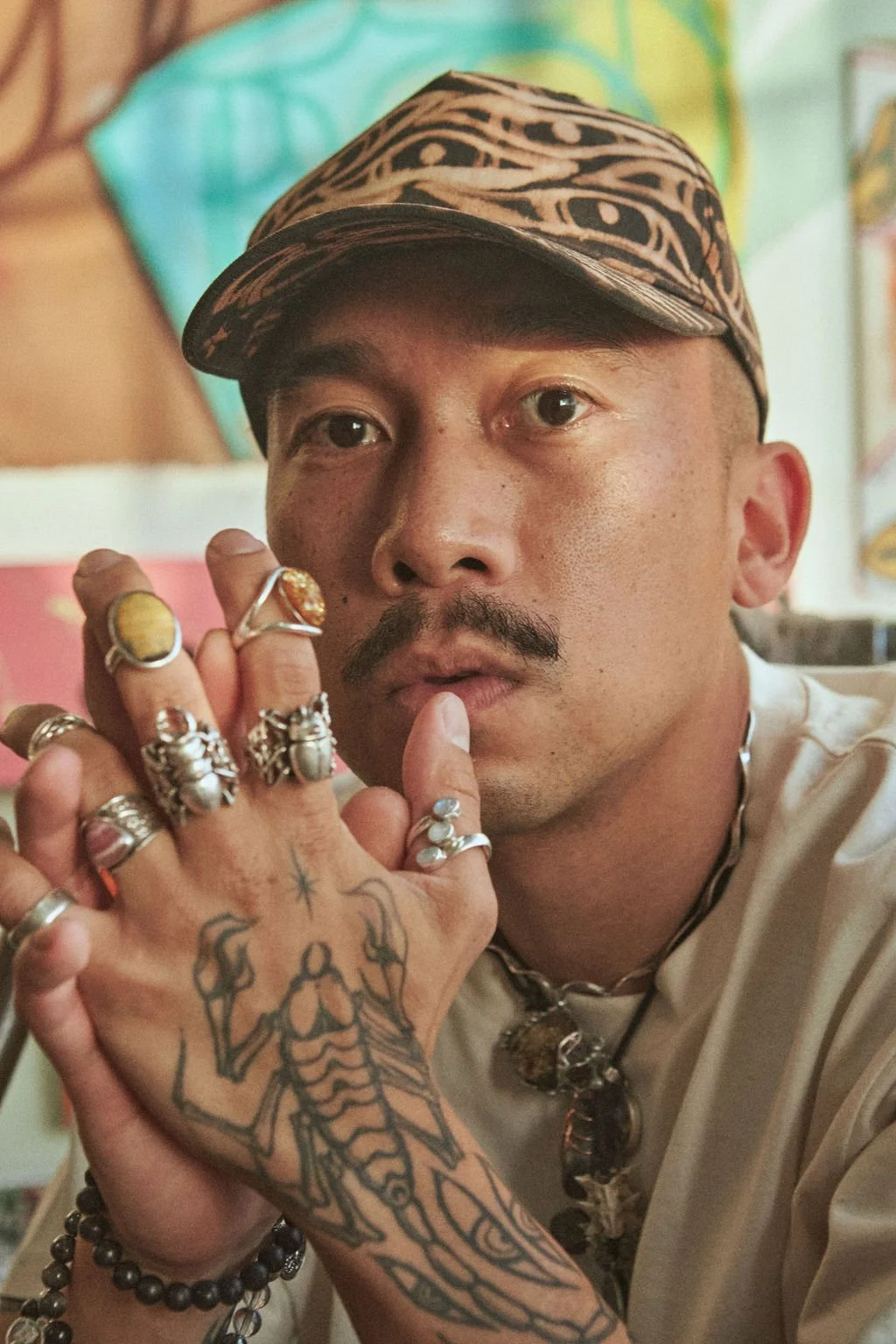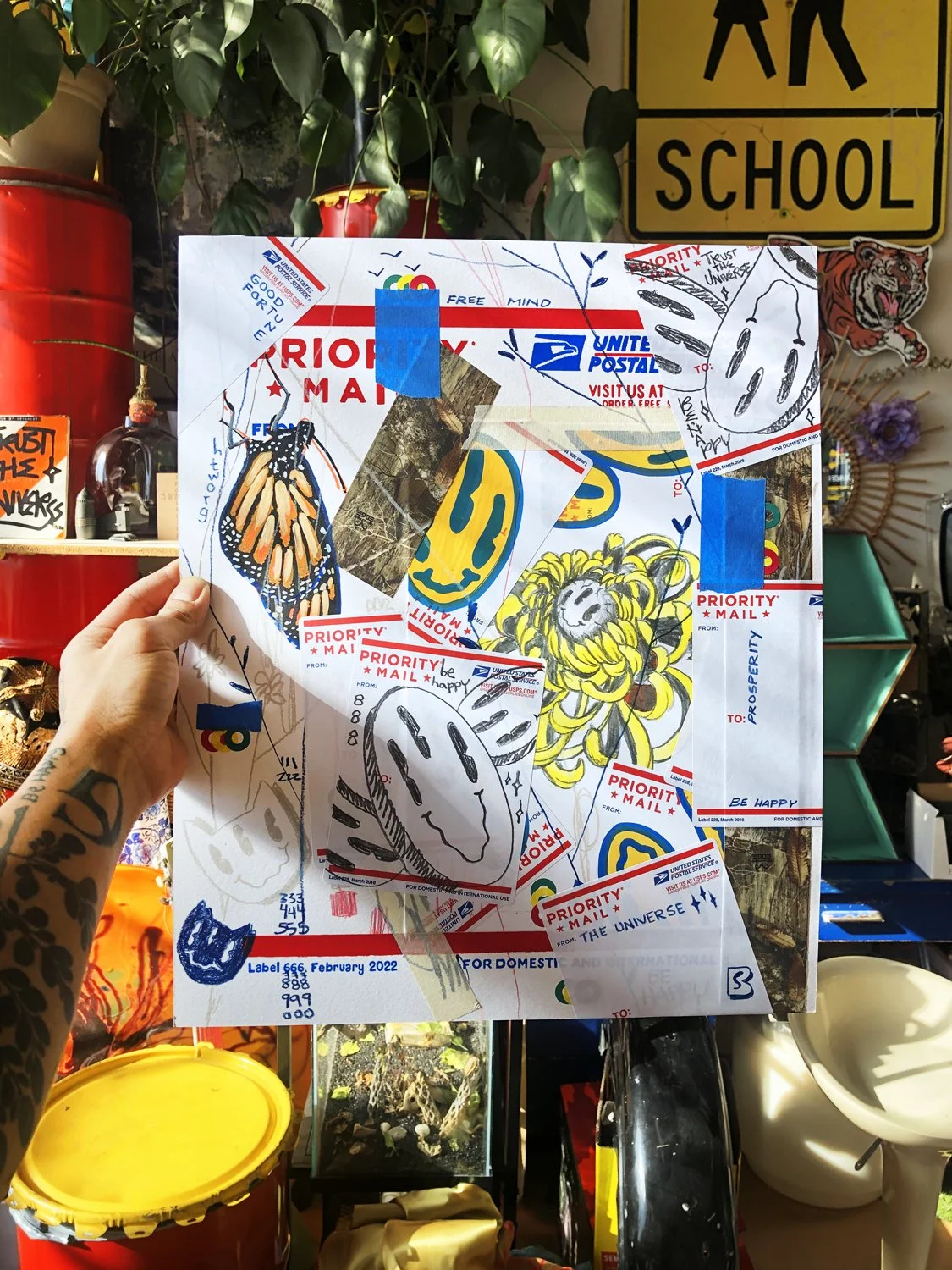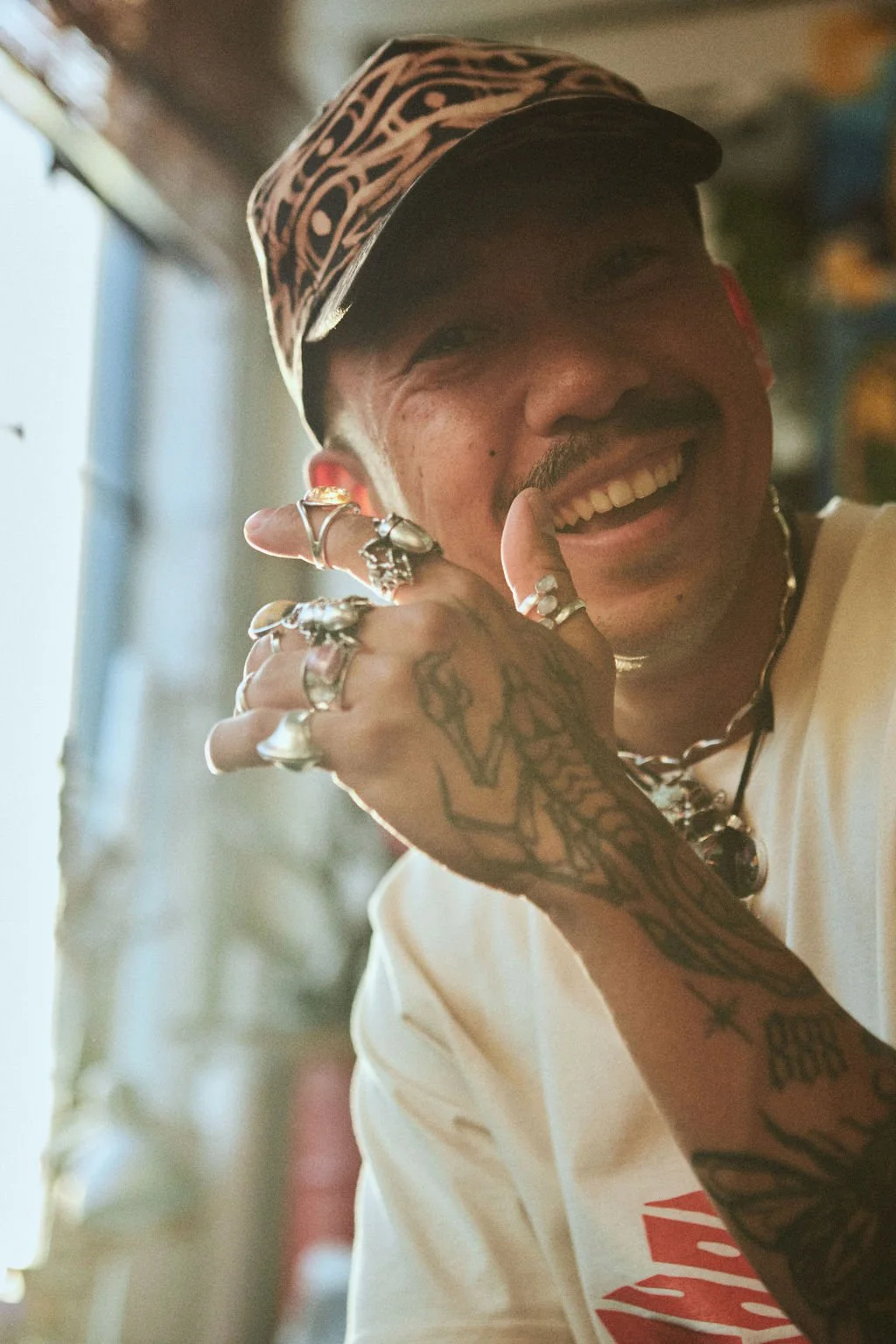Studio Visit & Interview with Bryant Sina
By Bolo Young
Photo By Miles Caliboso
“What is it about fire? So calm and peaceful but inside… It's hiding something. Just like people do. Sometimes you have to get close to find what's inside. Sometimes you have to get burned to see the truth.” -Jiccha from Tekkon Kinkreet
Life is a blend of chaos and order, where one’s attempt to find harmony can be an internal struggle as life continuously tilts to one side or the other. Existing in this world, the balancing act is a ride of emotions that is unique to each individual. Through navigating this difficult equilibrium, Bryant Sina finds peace in the residuals by truth to his inner self.
Based out of Haus of Godspeed Studios in Oakland, CA, the multidisciplinary Bryant embodies this balance. Raised in a subservient immigrant household, where art is viewed as a trivial phase or hobby, Bryant grew up rooted in the thrills of bombing graffiti on walls while ducking police in his teenage years. A graduate of California College of the Arts, he then went on to soaking up art history, creating works for grades, and learning techniques from others. Yet it wasn’t until after college when Bryant chose to deconstruct and challenge the rules learned at CCA, and began developing what would come to be his present-day creative identity. Currently managing the financial responsibilities for the Haus of Godspeed, he’s now working on finding new ways to sustain without being controlled by it.
Being in constant motion, Bryant chooses to simultaneously keep still in order to find his artistic self. Life’s balancing act is his reminder of the choice to be positive. Simply put, he chooses to “Be Happy!”
Interview
10 years ago, you built a studio space, Haus of Godspeed, with a gang of homies in Oakland. What is the meaning behind the name? Was there a theme built around the idea of having a creative space with friends?
The homie, Darren, and I wanted to make an art collective with the other creative homies and we were thinking of names while working as sign artists at Trader Joe's. I had a Tumblr and I would end my posts with “Godspeed”, to wish someone safe travels and good luck and prosperity on their journey. The word Godspeed resonated because our homies each had their own creative journey and craft. Godspeed was a word that morally uplifted creativity and encouraged us to keep making art.
Haus of Godspeed studios. Photo by Miles Caliboso.
Darren thought of Haus. He got the word from Bauhaus, which was a famous design school from 1920-1930. The school was an influential part of modern design, art, etc. So using "Haus" was to show that we're an all encompassing art collective. Haus is German for house and it was a play on words because our studio housed artists with all types of creative disciplines.
Honestly we were a bunch of homies that grew up with each other throughout high school and college and we were each artistically inclined. We wanted to have a space to create without any outside distractions, and a space to create larger works. We just wanted to create, make art that aligns with our souls, and make our dreams as artists a reality.
Describe how Haus of Godspeed and the homies influence you creatively.
If it wasn't for the homies I'd be doing something else other than art. We were all invested into hip-hop culture. The homies were making beats, doing graffiti, break dancing, and rapping. I was able to soak up game when I was around them. We would share art influences, share art techniques, and hold each other accountable in our art practices. All the work we were making at the time inspired all of us to continue to make dope art. A transformative moment for sure.
Who/what were early influences in your work? How did those influences shape your style and direction?
When I started graffiti I would hit up Tower Records and buy graffiti magazines that showcased graffiti from around the world. Artists like Alex Pardee, Greg "Craola" Simkins, and Jonathan Wayshak, that illustrated a narrative in their work. Sam Flores, Jeremy Fish, Mars 1, Sylvia Ji, and the Upper Playground camp during the early 2000's. Hi Fructose and Fecalface.com kept me in tune with the underground contemporary work that was being made. I was collecting a bunch of Kid Robot toys during this time too. Gundam and Mcfarlane Toys were a part of my early influences. All these artists set the bar and seeing them flourish in the style of work they made, made me want to reach to those levels too. Studying their work allowed my brain to absorb different styles of art.
How did those influences help you artistically find your authentic self? What is the difference between authenticity vs. originality? Was there a moment you found liberation in discovering your authentic self through your works?
Learning from their techniques and applying it to my work until it evolved into my own. I felt like I was taking different art styles and putting parts of their ingredients into my creative pot. As time went on I was able to take a few ingredients out, add new ingredients, transform ingredients, until I was able to create my own melting pot of styles that eventually would be cooked into my own creative soup.
Photo by Miles Caliboso
Authenticity for me is creating work that is related to my experiences in my life. Drawing imagery that reflects who I am and my personal interests. Originality is creating something new that no one has ever seen by using a specific medium in a clever way. Originality can be creating a new idea or a new world that brings new awareness.
I’d say there were 3 distinct experiences in my life where I found liberation in discovering my authentic self through the work I've made during these specific timelines; 1) Graffiti, 2) The years to come after art school, and 3) Teaching art to kids.
1) When I did graffiti in high school with the homies, I felt free to create. The rush of leaving the house at 2 a.m. to walk on train tracks, so we can piece walls and not get caught up by 50 (police) or our parents, was a pivotal time for me in discovering my happiness and dedication for art.
2) After learning about so much art history, art techniques, tons of art critiques, and constantly making art academically, it was the years to follow in the studio where I was able to explore my mind more with the knowledge I’d gained. I was able to decompress, break rules that I had learned, and dissect my thoughts more, without the pressure of a grade.
3) Teaching kids for 3 years added more freedom to my work. Demonstrating the fundamentals of art to kids through making sample work allowed me to regain connection to my own inner child. I was able to create work that my inner child missed out on when growing up. I didn't have access to an after school art program when I was a kid so being surrounded by these kids in my early 30s, and watching kids that were 4 1/2 years old, sparked more freedom in the marks I made. These kids would be unapologetic with their marks, owning the rainbow or butterfly they created. Watching them feel the magic within their art process, and the magic within themselves to be limitless, gave me awareness of my own inner child. It opened the door to tap back into my younger self and have fun making art.
How is that conveyed in the direction of your art? Where does it fit into the meanings of your works?
Taking what I've learned over the years, the direction of my work is more playful. Letting the Graffiti Bryant express himself through bold “let's fuck shit up" marks, and letting my inner child explore colors in different mediums, while the academic Bryant sits and thinks about what marks he should add or take out next in the composition. Making conscious marks and intuitive energetic marks that feel like bursts of energy. The work explores the dark and light parts of my brain, the mature side and the younger parts of myself that continue to live symbiotically on the canvas and outside the canvas. Visually displaying different emotional states that I've gone through, which becomes a place to hold onto happiness.
You talked in depth about the influence your parents had in your life. What province in the Philippines are your parents from? What was it like there?
My parents came from the North of the Philippines, Ilocos Norte. My Mom's province is Pasuquin which is known for its farmland and fishing areas. Her province was small. Kids would walk barefoot in the rain from school. Families would have to pump water out from a well. It was rough. My Pops had it more rough. He lived in the mountains, Cagayan. His area was surrounded by nature. A lot of rice fields and farmland. He didn't have the luxury of water heaters and electricity, but had amazing views. My parents lived a simple life. They had a farm and were able to put food on the table and had a roof over their heads.
As a child of Filipino immigrants, how has it shaped you as a person and an artist? How have they challenged you?
Seeing the conditions where my parents grew up made me grateful for the sacrifices they've made to raise a family of three in America. But growing up in this western culture, I was embarrassed of my parents. I wasn't proud to be Filipino when I was young. I didn't know my identity and I was caught between being American and being Filipino. So my early work didn't consist of Filipino cultural references, but was developed through the lens of my western experience, which was through hip-hop culture. It wasn't until my mid 20s (when I was in art school) that I wanted to tap into my family's roots. The work became about nature. I was interested in the reasons why I gravitated towards nature. Shout out to my parents for keeping Filipino farm life traditions alive while growing up.
Being an artist of Filipino immigrants is tough. Art isn't a career choice they are too familiar with. They were familiar with stable jobs like the medical field, computers, or a 9-to-5 job that would pay well. Making art to them was seen as a hobby. Making art wasn't a "REAL JOB." They thought I was wasting my time. My parents didn't understand how art could flourish as a career choice. Being around this type of energy, you start to question, “is art the path to take?" Then self doubt starts to creep in. But that didn't stop me because I had support from my art professors, homies and family members that nurtured my creative light. I became really good at art and I knew after high school that I was going to make art no matter the differences I had with my parents.
What are some of the generational ideologies you have come to accept and reject?
"Go to school, get a job, marry, buy a house, have kids", “be a Nurse or find a job in computers", “if you have a lot of money, then you're happy", “work hard, stay in school." My parents worked in farms and factories and they know that working hard, saving money, equates to surviving in America. This is true. But doing something that you love to do and having a job that brings you happiness is something that my parents didn't have time to do. They were busy surviving in America. Having a job that involved the arts wasn't up to par with their generational ideologies.
They understood that an education opens up new doors. New job opportunities. My parents sacrificed their youth and an education to help their families survive in the Philippines to work in the rice fields. They didn't have the luxury to further their education. So the pressure of staying in school and having a college degree was engraved in my upbringing. They didn't have a set educational plan for me, they just wanted me to have a degree, so I took it upon myself to further my education in the arts. Shout out to my parents for helping me, even though they would've preferred a medical practice.
At the end of the day my parents wanted a better life for me and I chose a life that was foreign for my parents, but a life I knew that would sustain my happiness in the long run.
Your parents took a chance to immigrate to the US for an opportunity for a better life, literally crossing an ocean to pursue happiness, what ‘oceans’ are you currently crossing as an artist?
The ocean I am currently crossing is the business side of art. How to monetize the work being made. Making art will always be fun, but making a business out of the art is an ocean of endless possibilities. There's so many paths to take in the art world. It's up to me to choose a path or paths that resonate with my divine purpose. I've established a strong identity in my art, now it's a matter of organizing my artistry so I can be financially stable.
You mentioned the anime, Tekkonkinkreet, was inspirational to the “Be Happy” mantra you’ve adopted. How does your mantra relate to the anime?
"Be Happy" comes from the youngest character White. When his older brother, Black, is sad or is thinking too much, White says "be happy, be happy" to comfort his brother's mind. Reminding his brother that they can tap back into happiness. To remember to be happy, to be grateful, to know that they still have each other and that they've managed to survive on their own in a busy city. A reminder to smell the roses.
There’s a theme of duality in the movie, contrasting in the main characters, Black and White. What characteristics from Black and from White influence your work and your life outlook overall?
Black is an emotional character that explores his dark side. He sees the unethical parts in the city he's growing up in. Black is a bit more realistic with life and is more concerned about the livelihood for the both of them. The responsible sibling.
While White is just a kid. He's playful and innocent. Life is pure bliss and his imagination is endless. He's still fascinated with the beauty life has to offer.
When you look deeper into their characters, you find that both of them balance each other. This is where the Yin and Yang come in. The harmony they both achieve when they are together. Black and White; Yin and Yang.
Like these dualities portrayed in each character; my work is playful, but can tap into the dark parts of my mind which is communicated through the marks, imagery, and colors I use in my paintings. In life, it's about finding a balance within my emotions so I can tap back into my happiness. The voices in my head can be toxic. Yes, I can be depressed or angry, but at the end of the day how do I come to peace with those emotional states? The goal for me is to enjoy life with all the ups and downs.
What other inspirations did you take from the anime?
The animation alone. The graphics are amazing!!! Detailed backgrounds contrasted with characters that are minimal in design. Most of the landscapes are hand painted by the animators.
What connects you to happiness? What makes Bryant Sina happy?
The things that help me connect to happiness are exploring nature, making art, crying, exercising, biking, meditating, and focusing on my gratitudes. What makes me happy is being surrounded by loved ones, being around creative people, watching nature and art documentaries, and listening to music that can make me feel my emotions.
Any upcoming projects/works/endeavors?
Setting up a digital shop for Haus of Godspeed so people can have access to work that's being made in the studio from our artists. Been sewing and bleaching a bunch as a side project. I have a few group shows lined up. Working on a “Be Happy" with friends art show where all the art will be collaborative work. Lastly, tattooing is around the corner waiting for me.
You mentioned opening the studio to the public more. How can people visit the studio as well as cop merch?
Right now I have the studio set up as a mini gallery and mini shop. People can slide through to the studio by appointment only. Just hit my IG or the Haus of Godspeed IG and we can set that up. I'm usually at the studio Monday through Friday.
How can the public follow your journey and get in contact with you?
My current works can be seen through my IG, @bryant.sina and through my website, www.bryantsina.com. Folks can contact me on IG or by email at hausofgodspeed888@gmail.com.
Photo by Miles Caliboso





























